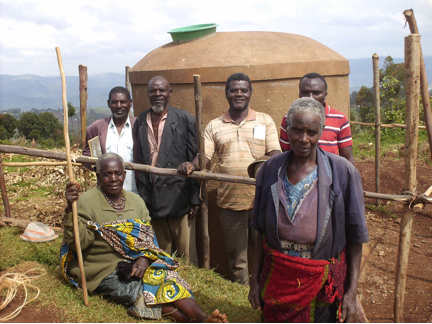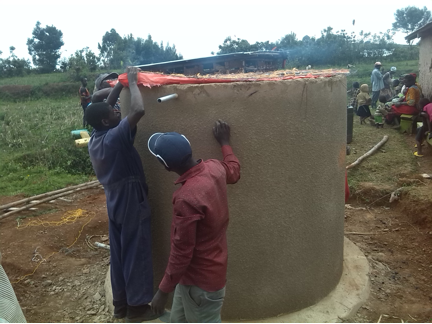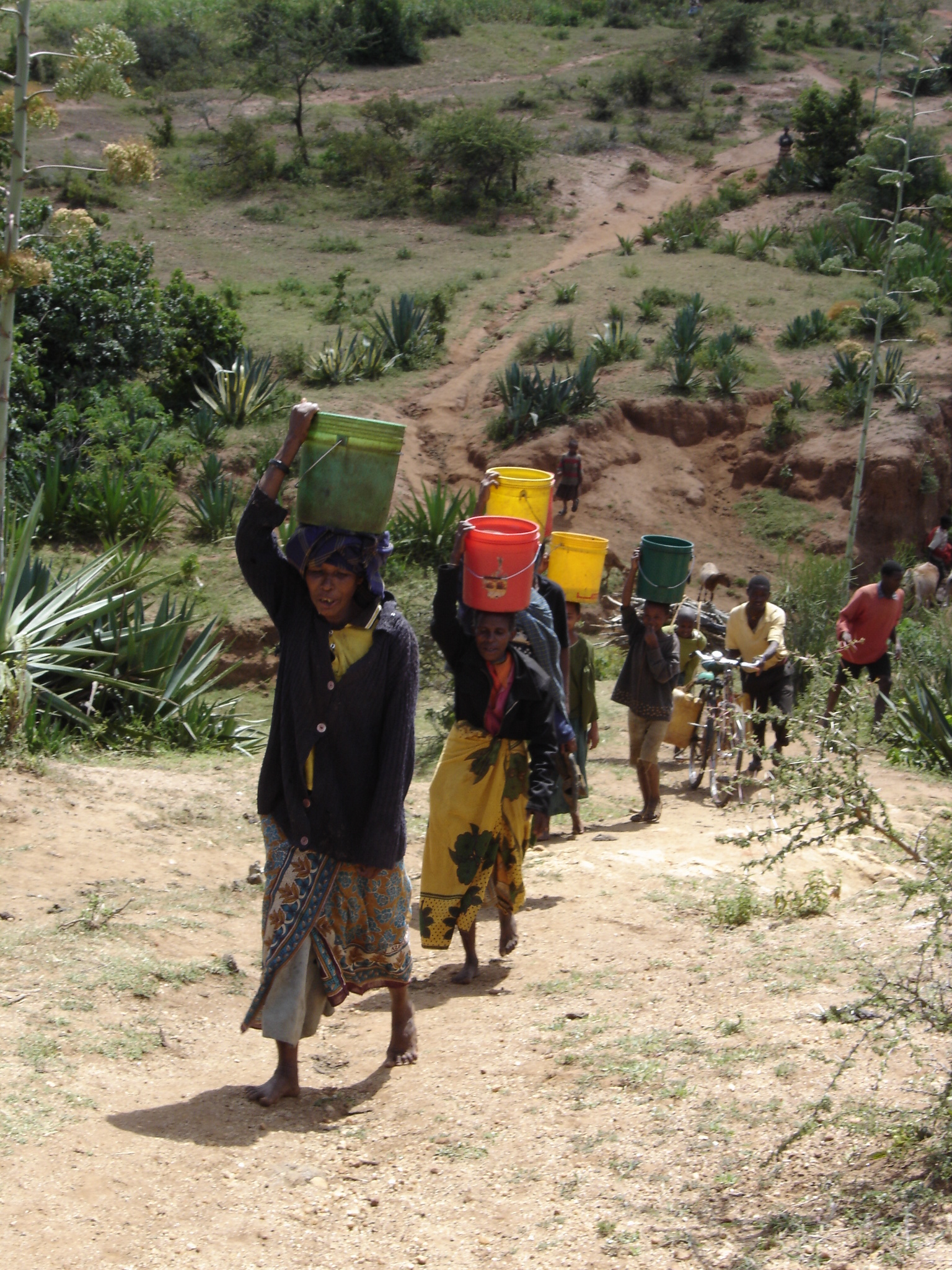Kitooma Rainwater Harvesting Project
Fundraising campaign by
Jason Gerber
-
US$0.00Donated So Far
Campaign Story
I was born and still live in Kitooma, the highest ridge in Kabale, Uganda, 2500m (7430ft) above sea level. My village has a population of 3500 people living in close to 900 houses, yet the entire community suffers from a lack of any reliable water source. Everyday, the members of my village have to walk close to three hours to collect water from Lake Bunyonyi or distant valley wells and return with it up steep mountain paths. With the funds from this project, we hope to build rain water collection tanks and water filters to ease this burden and support healthy and self-reliant communities.

Introduction
Kitooma Parish is found in Rubaya. Rubaya is a sub-county of Kabale District in Uganda. Kabale is Uganda’s highest located town and is considered to be the Little Switzerland of Africa. There are stunning and impressive views and it is known to be a major agricultural and tea growing area. Surrounding this area is Lake Bunyonyi and the Kitooma Ridge. Kitooma lies at the peak of the surrounding hills. The area has an altitude of 7430ft or 2500m above sea level and is located about 1.5 hours steep walk from Lake Bunyoni.
Kitooma Parish contains a diverse number of people with different, but similar cultures. The population of Kitooma is 3508 people who live in 877 houses, and is comprised of a variety of family structures. With that said, most families have about 6 members, which include children below the age of 10 years. Additionally it has about 2 members who are above the age of 60 years. As life expectancy in Uganda reflects social factors such as health care, disease control, immunization, overall living conditions and nutrition, these elder members often become too old or unfit to venture for two hours to reach the watering hole or sustainable well for water. As a consequence, a communal problem of water access spawns specifically during the dry season.
The dry season is generally three months long from June until the end of August. This causes a multitude of problems directly linked to attaining water. These mishaps include inappropriate fighting amongst locals as people fight for water, especially during the morning and evening times. This is when most children have come back from the school and go to get water, and the strong ones push the weaker ones away. Some children go home with empty cans crying and generally breaking the cultural dynamic of the community. All of this is due to the shortage of water available at the well.
The general daily consumption of water per day is about 1620 liters for 81 people whereby each person uses 20 liters and in three month each person uses 1800 liters of water. The water is collected from a distant water well where by about 10 to 20 people gather to collect the little water that comes from the protected well which gives limited water that is why people use less water than normal during the dry seasons.
It is “survival for the fittest”, and this has the biggest impact on the elders and young ones unable to fight their stronger opponents over water. This causes inequality within the communities. Some are forced all the way down to the lake for water.
In addition, domestic animals, like cows, do not have enough drinking water during this season due to the fact that people are consuming most of it. This leads to a lack of water for livestock, as well as cooking and bathing. Rather than providing the livestock with sufficient amounts of water, it is primarily being used for the irrigation of the nearby household crops. This shortage of water leads to a severe burden on the livestock and consequently the whole community’s food production.

Project aims and objectives
- Poverty eradication. Mainstreaming cross cutting issues of environmental sustainability, food production and food security.
- Promoting education .Children have time to concentrate on education instead of walking far distances to get water
- Sanitation. Improved and sustainable water sanitation services in targeted communities of Kabale.
- Environmentalism
- Self-reliance. To equip the local community members with interested individuals with skills and practices in water and sanitation.
- Health. To provide safe water filters especially for women and their babies so that they can have clean water. This is to prevent water borne diseases and reduce the burden of hauling from long distances on steep hills of Kabale
- To reduce time and energy wasted in water hauling from long distances
How will this project change the community?
* Improved water quality due to sand and cement filters will result in fewer cases of diarrhea and other water borne diseases
* Providing water to those that cannot retrieve it themselves, supporting the most at-risk members of the community
* Increasing food production by providing a more stable water source to crops during the dry season
* Less labour needed for long distance walks carrying heavy cans will provide the community with the opportunity to put that labour to use in other ways (agriculture, education, manufacturing, etc...)
* Allowing some animals to be watered nearer to home, keeping families together
* Decreasing conflict level in the community
Who should receive this help first?
The elders, orphanages and widowers as they are the most vulnerable and have the hardest time getting water from existing far away sources.

Plan (construction and funding of the water tanks)
The plan is to find a way of collecting rainwater by building rainwater harvesting tanks built of CEMENT, STONES and some sand and the other one is A PLASTIC CREST TANK with its picture below. This tank is not as expensive like a cement tank as it requires less labor and building materials.
A big tank built at the community house where 63 people for water. These tanks have to be built next to the house so each house has its individual tank. Each holds 6,000 liters, which should last for three months depending on the consumption. The dry seasons start from the beginning of June and lasts until the end of August. During this time people are able to use this saved water.
Table showing the cost of one tank
| Item | Quantity | Amount (sh) | Total Amount (sh) | USD |
|
Cement |
12 bags |
35,000sh |
420,000sh |
128$ |
|
Had core stones |
1 tipper |
200,000sh |
200,000sh |
63$ |
|
Gravel stones |
1 tipper |
240,000sh |
240,000sh |
75$ |
|
Sand |
1tiper |
190,000 |
190,000sh |
|
|
Wire mesh |
1roles |
60,000sh |
60,000sh |
19$ |
|
Chicken wire mesh |
1role |
50,000sh |
50,000sh |
16$ |
|
Plain wire |
15kg |
15,000sh |
150000sh |
46$ |
|
Banding wire |
15kg |
10,000sh |
100,000sh |
32$ |
|
Empty sacks |
10 |
1,000sh |
10,000sh |
32$ |
|
Sisal rope |
1 |
4,000sh |
4,000sh |
2$ |
|
Tap, |
1 |
25,000sh |
25,000sh |
8$ |
|
Over flow |
1 |
25,000sh |
25,000sh |
8$ |
|
Wash out |
1 |
25,000sh |
25,000sh |
8$ |
|
Gutter |
20fit |
80,000sh |
80,000sh |
25$ |
|
Basin |
1 |
4,500sh |
4,500sh |
2$ |
|
Labor |
1 engineer |
350,000sh |
350,000sh |
109$ |
|
|
|
|
1,873,500sh |
585$ |
This total amount is for one tank and we hope we are able to raise this amount of money from personal donations or organizations.
The task of building these tanks will be led by water tank engineer TUKACUNGURWA GORDON. He will instruct the community members so that they can learn how to build them. A selected group of community members will provide labor. Those involved will be able to teach other members of the community and future generations to do this for themselves.
Number of tanks required
To start with, there are 23 houses where widowers and orphans live that should be prioritized. To begin with, some homes can share a tank depending on how much money is raised.
In the future, we hope to be able to raise enough fund so that each house (877 of them) can get its own tank and eventually we'd like to bring a similar model to the entire region.
Personal experience in community projects.
In 2010 I started a goat keeping project with 145 needy people of which 92 orphans and 53 widowers were supported. 45 goats were given to widowers and orphans in 3 villages of Kakooko, Buhumba and Katooma. These goats have been shared among the families and when a goat produces an offspring, it would be given to another family member. Per 2015 we have 125 goats for 125 members. Our community has 145 people so we are left with 20 who are still waiting to get a goat from their friends in future.
This has done something good for the community by giving manure for the crops and some goats have been sold to pay for the school children’s fees, uniforms and other school material.
In 2013 I did an Irish potato growing project up on hills of Butenga, Rwanyena and Kitooma. The money raised bought 4 sacks of seeds. From the seeds planted, 25 sacks of potatoes were harvested for the members to share. They are still planting the same potato species.
This is a sustainable community project. The water tanks will last for a long time and the number will continue to increase as new families emerge. Community members with the skills to build these tanks will continue to teach others how to do so.
Each water tank should serve the family with at least 40 liters per day.
This project has to be monitored by the community leaders mentioned below, as well as the Project initiator Friday Smith.
Project well wishers
- Rev of Kitooma church Uganda
- Head Master Kitooma Primary School
- Chairman LC1 Kitooma Village
- Chairman LC2 Kitooma Parish
- Chairman LC3 Rubay Sub County
- Sub County Chief Rubaya Sub County
- Executive Directors of Kitooma Parish
- Chairman of the Board of Directors
- Teaching staff and non-teaching staff of Kitooma Primary School
- Kitooma Water Project board members
- The community at large
FINANCIAL COMMITTEE
| Rev. Kitooma Parish | Rev Katushabe Agrey |
| Chaiman lc 1 Nyakabungo Village | Mr Mageyi Wiwliam |
| Water Project Chairman | Muhozi Banard |
| Project Director | Mr Friday Smith |
| Woman Chairperson | Kicoonco Eunice |
| Project Secretary | Tinyebirwe Mercy |
Acknowledgement
I would want to extend my sincere thanks to the donors Mr Martin and Mr Andrea from Germany for their contribution and constant communication until when their donation reached to the final destination as the first donors for the first two tanks which were built 2016. Thank you very much gentlemen.
I would also want to send my gratitude to the family of Phil Hitchen from UK which donated for the 3rd tank in 2017. Phil, thank you very much for editing my project proposal and the up growth of the project.
My sincere thanks also goes to Astrid and Jasper for they have moved up the hill to see what is going on there and spread the gospel, we hope something will happen and change the community.
I would also want to thank Jason and Elena from USA for their effort and contribution to words the building of the fourth tank, thank you very. With hope and support from you we can help the community.
I would want to thank everybody who has gone through this proposal, you small contribution can grow into something big.
Thank you.
Friday Smith
Thank you for the support in finance and ideas
Your small donation can result into something big!
Email: [email protected] / [email protected]
Phone: +256 752363376, +256 779799906
Fundraising Team
- Jason Gerber
- Digital Assistance
- Jason Gerber
- Funding
No updates for this campaign just yet



